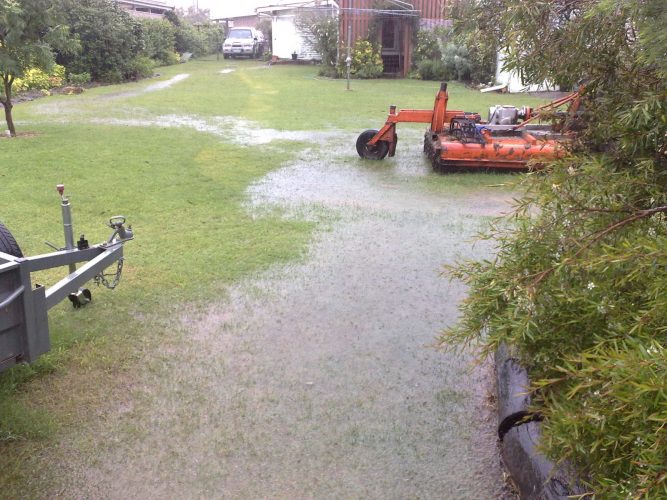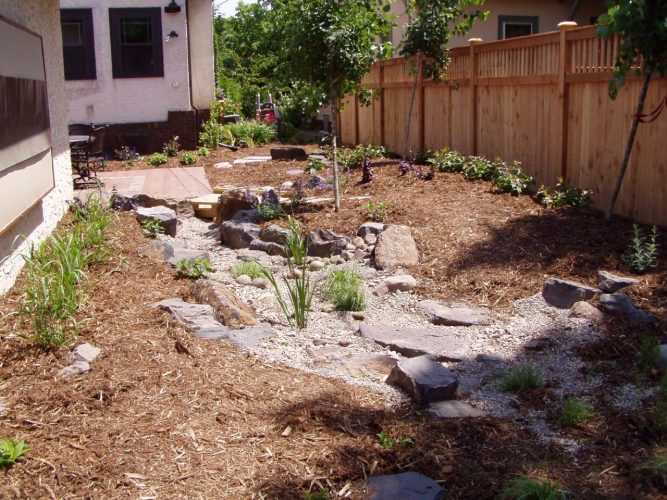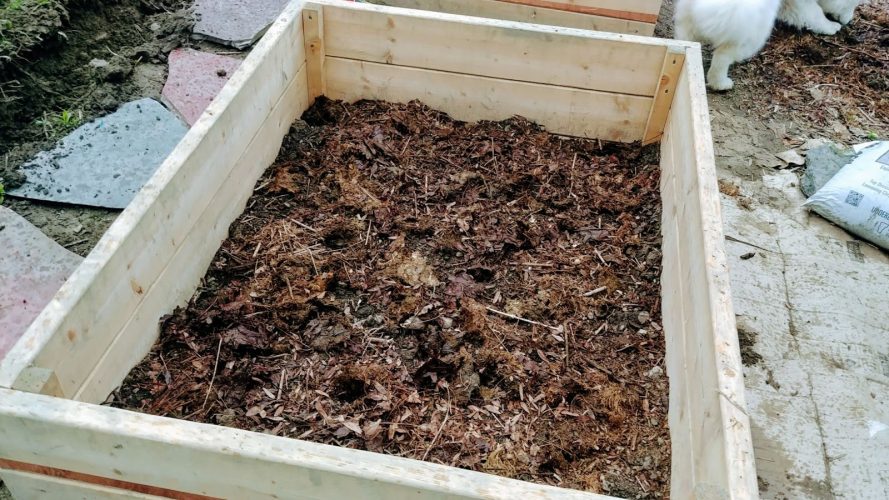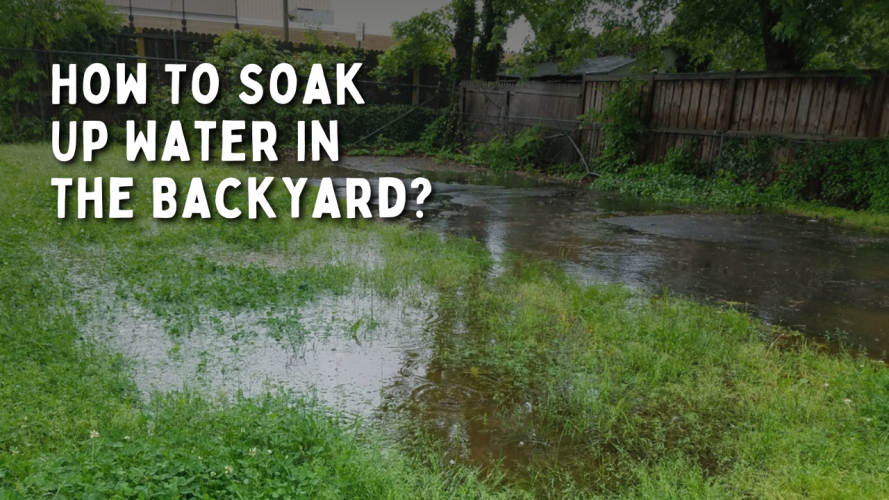How To Soak Up Water In The Backyard?
Have you ever experienced a flooded backyard after heavy rain or a plumbing mishap? Don’t worry; you’re not alone.
Soaking up water in your backyard can seem daunting, but with a few simple tips and tricks, you can have your yard looking dry and back to normal in no time.
In this article, I’ll explore various methods for soaking up water in your backyard and preventing future flooding.
What Causes Water in Backyard?
You might have water in your backyard for several reasons. Some of the most common causes include:
Poor Drainage
If your backyard is sloped or has poor drainage, rainwater can collect in low areas and cause puddles.
Heavy Rainfall
Suppose you live in a place that receives heavy rainfall. In that case, the ground in your backyard may become saturated and unable to absorb more water, leading to standing water.

Underground Springs or Seepage
If you live in a place with underground springs or seepage, water may naturally come up to the surface in your backyard.
Leaking Pipes or Irrigation Systems
If you have leaking pipes or irrigation systems in your yard, they can cause water to pool in certain areas.
Overwatering
If you water your lawn or garden too much, the excess water can pool and create standing water.
If you have water in your backyard and you’re not sure what’s causing it, it may be helpful to consult with a landscaping professional or plumber to help identify the source of the problem.
How to Soak Up Water in Backyard?
Here’s a list of techniques that you can use to soak up water in your backyard:
1. Use a Sump Pump
A sump pump is one of the most efficient ways to eliminate standing water in your backyard. A sump pump is designed to pump water out of your yard and into a drainage area.
To use a sump pump, place it in the area with the most standing water, and turn it on. It will quickly remove the water and help to dry out your yard.
2. Create a Dry Well
A dry well is a deep, underground pit that collects and absorbs excess water.
To create a dry well, dig a hole in the ground and line it with landscape fabric or geotextile. Then fill the hole with a layer of gravel, followed by a layer of sand.
Finally, add a perforated drain pipe and cover it with more gravel. This will allow the water to drain into the well and be absorbed by the sand and gravel layers.
3. Install a French Drain
A French drain is a trench loaded with gravel and a perforated pipe. It’s designed to redirect water from your yard into a drainage area.
To install a French drain, dig a trench with the most standing water and line it with landscape fabric. Add a layer of gravel, followed by a perforated drain pipe.
Cover the pipe with more gravel and wrap the landscape fabric around the top. This will allow water to flow into the drain and be redirected away from your yard.
4. Use Absorbent Materials
If you have a small amount of standing water in your backyard, use absorbent materials like sand, mulch, or kitty litter to soak it up.
Spread the absorbent material over the water and let it sit for a few hours. Once the material has absorbed the water, you can remove it with a rake or shovel.
5. Build a Raised Bed
Building a raised bed can help to prevent standing water in your yard.
To build a raised bed, create a border using bricks, stones, or wood planks. Then fill the bed with a mixture of topsoil and compost.
This will allow water to drain more efficiently and prevent it from accumulating in one area.
6. Plant a Rain Garden
A rain garden is a type of garden that is designed to absorb and filter rainwater.
To create a rain garden, choose an area in your yard prone to standing water and remove any grass or vegetation. Dig a shallow depression and fill it with sand and compost.

Flickr Image by Field Outdoor Spaces
Plant native plants and shrubs that are adapted to wet conditions. This will help to soak up excess water and prevent it from causing damage to your yard.
7. Create a Swale
A swale is a type of shallow ditch that is designed to redirect water away from your yard.
Dig a shallow trench in a zigzag pattern across your yard to create a swale. Fill the trench with gravel or rocks, then cover it with soil.
This will allow water to flow into the swale and be redirected away from your yard.
7. Install a Permeable Paver
Permeable pavers are designed to allow water to seep through them and into the ground below.
To install permeable pavers, dig a shallow trench in the area where you want to install them. Fill the trench with a layer of gravel, followed by a layer of sand. Then install the permeable pavers on top.
This will allow water to flow through the pavers and into the ground below.
8. Build a Retaining Wall
If your yard is on a slope, you can build a retaining wall to prevent water from accumulating in one area.
To build a retaining wall, dig a trench at the base of the slope and fill it with gravel. Then install a row of landscape timbers or blocks on the gravel.
Continue adding rows until the wall is the desired height. This will prevent water from flowing down the slope and causing damage to your yard.
9. Use a Wet Vacuum
If you have a small amount of standing water in your yard, you can use a wet vacuum to remove it. A wet vacuum is a type of vacuum cleaner that is designed to pick up liquid.
To use a wet vacuum, attach the appropriate attachment and suck the water. Empty the vacuum’s container frequently to prevent it from overflowing.
10. Install a Rain Barrel
Installing a rain barrel is a great way to collect rainwater and prevent it from causing damage to your yard. A rain barrel is a container placed under a downspout to collect rainwater.
To install a rain barrel, place it under a downspout and attach a hose to the fixture. This will allow you to use the collected rainwater for watering your plants or garden.
Additionally, by collecting rainwater in a barrel, you are reducing the amount of water that flows into storm drains, which can help to prevent flooding in your area.
11. Install a Swirl Filter
A swirl filter is a filtration system that removes solid debris from the water, making it easier to disperse into the ground.
It’s useful if you have a lot of debris in your backyard or want to avoid the risk of clogged pipes or other drainage systems.
12. Create a Rain Chain
A rain chain is a series of metal or plastic cups hanging from a chain, which redirects water from your roof to a specific location in your yard.
Using a rain chain, you can direct the water flow and ensure it’s absorbed into the ground instead of pooling on the surface.
13. Build a Hugelkultur Bed
A hugelkultur bed is raised from decomposing wood, leaves, and other organic materials.

Flickr Image by sk
As the organic matter decomposes, it creates a spongy, nutrient-rich bed that can absorb and retain water, making it ideal for areas with poor drainage.
14. Use a Wetland
A wetland is an area specifically designed to filter and absorb water. By creating a wetland in your backyard, you can direct water to a specific area and ensure that it’s being absorbed into the ground.
15. Plant Trees
Planting trees in your backyard can help to absorb excess water and prevent it from pooling on the surface. Trees have deep roots that absorb large amounts of water, making them an effective tool for preventing standing water.
Using these techniques, you can effectively soak up water in your backyard and prevent further damage.
Choose the best technique for your situation and take action quickly to prevent standing water from causing damage to your yard.
Final Thoughts
In conclusion, waterlogging in your backyard can be a frustrating experience.
However, following the techniques above, you can effectively manage the problem and prevent further damage to your yard.
Whether you use drainage solutions, landscaping techniques, or absorbent materials, the key is to act quickly and efficiently.
So, next time you face a waterlogging problem, don’t panic; follow these simple steps and restore your backyard.


